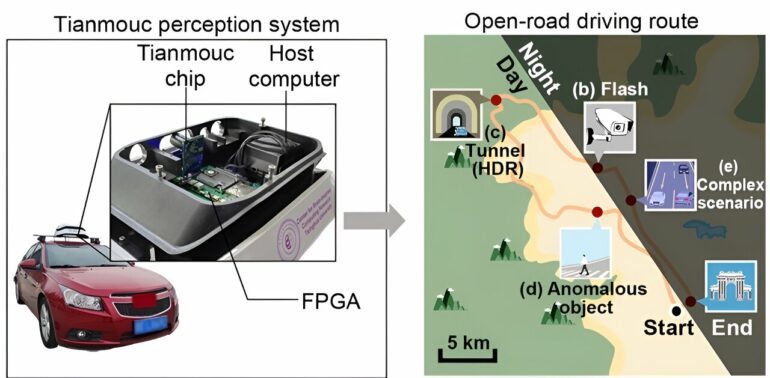With the rapid advancement of artificial intelligence, unmanned systems such as autonomous driving and embodied intelligence are continuously being promoted and applied in real-world scenarios, leading to a new wave of technological revolution and industrial transformation. Visual perception, a core means of information acquisition, plays a crucial role in these intelligent systems. However, achieving efficient, precise, and robust visual perception in dynamic, diverse, and unpredictable environments remains an open challenge.
In open-world scenarios, intelligent systems must not only process vast amounts of data but also handle various extreme events, such as sudden dangers, drastic light changes at tunnel entrances, and strong flash interference at night in driving scenarios.
Traditional visual sensing chips, constrained by the “power wall” and “bandwidth wall,” often face issues of distortion, failure, or high latency when dealing with these scenarios, severely impacting the stability and safety of the system.
To address these challenges, the Center for Brain Inspired Computing Research (CBICR) at Tsinghua University has focused on brain-inspired vision sensing technologies, and proposed an innovative complementary sensing paradigm comprising a primitive-based representation and two complementary visual pathways.
The research paper based on these results, “A Vision Chip with Complementary Pathways for Open-world Sensing,” was featured as the cover article of Nature in the May 30, 2024 issue.
Inspired by the fundamental principles of the human visual system, this approach decomposes visual information into primitive-based visual representations. By combining these primitives, it mimics the features of the human visual system, forming two complementary and information-complete visual perception pathways.

A Tianmouc chip (left) and a perception system (right). © Tsinghua University
Based on this new paradigm, CBICR has developed the world’s first brain-inspired complementary vision chip, Tianmouc. This chip achieves high-speed visual information acquisition at 10,000 frames per second, 10-bit precision, and a high dynamic range of 130 dB, all while reducing bandwidth by 90% and maintaining low power consumption. It not only overcomes the performance bottlenecks of traditional visual sensing paradigms but also efficiently handles various extreme scenarios, ensuring system stability and safety.
Leveraging the Tianmouc chip, the team has developed high-performance software and algorithms, and validated their performance on a vehicle-mounted perception platform running in open environments. In various extreme scenarios, the system demonstrated low-latency, high-performance real-time perception, showcasing its immense potential for applications in the field of intelligent unmanned systems.
The successful development of Tianmouc is a significant breakthrough in the field of visual sensing chips. It not only provides strong technological support for the advancement of the intelligent revolution but also opens new avenues for crucial applications such as autonomous driving and embodied intelligence.
Combined with CBICR’s established technological foundation in brain-inspired computing chips like Tianjic, toolchains, and brain-inspired robotics, the addition of Tianmouc will further enhance the brain-inspired intelligence ecosystem, powerfully driving the progress of artificial general intelligence.
More information:
Zheyu Yang et al, A vision chip with complementary pathways for open-world sensing, Nature (2024). DOI: 10.1038/s41586-024-07358-4
Provided by
Tsinghua University
Citation:
Cutting-edge vision chip brings human eye-like perception to machines (2024, June 5)



